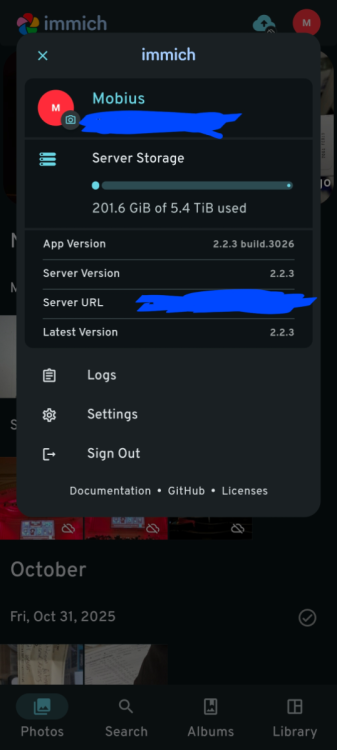All Activity
- Past hour
-
splinter9696 joined the community
-
Let's Talk About Immich If you've been running Immich on HexOS this year, you know it hasn't been smooth sailing exactly. We want to talk about what's happened, why it was so challenging, and how we're working to handle these situations better in the future. What Happened? Earlier this year, Immich deprecated their old storage configuration and required all users to migrate to a new structure. For users running Immich through docker-compose or other manual setups, this meant updating some configuration files and running a few commands. Annoying, but manageable. For some HexOS users, the migration was more involved. Because of how TrueNAS SCALE structures application storage, moving to the new configuration required either reinstalling Immich fresh (the simplest solution) or manually migrating existing data between datasets (a process that involved SSH access, rsync commands, and careful attention to permissions). But if you're choosing between "reinstall the app" or "follow a 15-step guide," neither option feels great when you chose HexOS specifically to avoid that kind of complexity. Why Was This So Hard? When Immich made this change, we had a choice to make. We could have built a comprehensive rsync-based migration tool using the TrueNAS API. It has those capabilities. But that would have meant dropping everything else we were working on to build what amounts to using a cannon to kill a mosquito: a massive, complex solution for what we hope won't be a regularly recurring problem with this particular app. Instead, our community stepped up in a huge way. Users like @forsaken and @G-M0N3Y-2503 created detailed guides (to move or rsync your data). These guides walked through the manual migration process to preserve existing data in Immich. They focused on helping users through the immediate problem, while we continue building the platform we need to handle situations like this properly. That platform is HexOS Local: a locally-hosted management application that will let us perform complex operations without being bottlenecked by the engineering overhead of building one-off solutions through the SCALE API every time an application throws us a curveball. This reduces the technical burden on our team and, more importantly, gives us the flexibility to automate maintenance tasks that previously would have required manual intervention or massive engineering investments. This same platform will serve the Local UI/UX feature we've committed to delivering as part of our 1.0 release. We'll be talking a lot more about HexOS Local in an upcoming blog post, but the key takeaway is this: we're building HexOS to handle whatever the open-source ecosystem throws at it, without having to choose between "drop everything and build a custom tool" or "make users SSH into their servers." What About Right Now? If you're currently running Immich on the old storage configuration and haven't migrated yet, you have options: The simple path: Reinstall Immich fresh with the new configuration. Your photos will need to be re-uploaded, but the setup is clean and straightforward. The preservation path: Follow one of the community migration guides to keep your existing data in place. These guides are more technical and require command-line access, but they work. Our recommendation depends on your situation. If you have a manageable photo library and good backups, the fresh install is probably your best bet. If you have years of photos, carefully organized albums, and user configurations you don't want to recreate, the migration guides are there for you. And if this seems to daunting, email support@hexos.com so we can schedule a time to assist you directly. Moving Forward The Immich situation showed us exactly where we need to invest engineering effort. We can't keep facing the choice between building massive one-off solutions or asking users to break out the terminal. That's not sustainable, and it's not the HexOS we're building. Immich is an incredible project. It's exactly the kind of self-hosted solution we want to make accessible to everyone. The team behind it recently released v2.0, marking their stable release with better upgrade paths going forward. We're committed to making sure that when the next complex maintenance task comes up, whether it's Immich or any other application, we have the infrastructure in place to handle it gracefully. That's the HexOS we're building. Thanks for your patience while we get there.
-
- 1
-

- Today
-
Barakisa started following Access hexos remote
-
liamd1985 joined the community
-
snipersixate joined the community
-
DeathFist joined the community
-
kingtank joined the community
- Yesterday
-
Project_Maxine joined the community
-
Yves Desjardins started following Mobius
-
Justin_Floor joined the community
-
jonp started following Let's Talk About Immich
-
It would be nice if there were features that allow TrueNas/HexOS to run in parallel like Proxmox and VMWare. Truenas has capabilities of running virtual machines, if we could have the ability of having those VMs switch from one host to another if one fails then I believe that this would be fully capable of replacing Proxmox/VMWare.
- Last week
-
I would guess it's so Windows can map a network drive. Well maybe not just windows but if it wasn't that way I would not be able to load my photos, movies or general videos. If that's not the reason, don't tell me. I don't want to know.
-
So far the best solution ive found is a shortcut on the desktop to the server ip and it shows all shown shares there, but there has to be something better than that right? you cant even pin a shortcut to quick access or anything
-
dru-da-fool started following Immich not working
-
Why does the default config create an SMB share for every single (top level, like Photos/Videos) folder instead of one for the storage pool? I looked at the truenas panel, and it said that doing it that way would create config issues, but it seems really inconvenient to add every single folder manually. The machine shows up in my network tab in file explorer, but when I try to open it, it says windows cannot access it. Is there a better way to do this? I'm sure there is, but is just cant find it.
-
Any opinions on an Intel X540-T2 RJ45 DUAL port 10G Base-T NIC? Are drivers for HexOS easier to find than Marvell?
-
Hey, Buddy Backup isn't currently available and Hexos doesn't offer anything to do a backup to another machine. However if you login to Truenas go to Data Protection and there to the Replication Tasks. You can setup a new Replication task there following this guide: https://www.truenas.com/docs/scale/25.04/scaletutorials/dataprotection/replication/ But this requires that you can connect to the other server, via tunnel or domain name or sth. Similar.
- 1 reply
-
- 3
-

-
Hi all, I’m running two HexOS servers: one for personal use and one for my band. I recently heard about “Buddy Backup” and was wondering whether this feature is already integrated or if there is any public information about when it might be released. If it’s still a long way off, I would like to know how you would set up a backup from one server to the other in the meantime. Both servers are located in different buildings, use separate HexOS accounts, and each has its own storage pool dedicated to backups of the other server. One of the servers is already connected to the internet through a Cloudflare tunnel. Thanks in advance for your help! Best regards, Niklas
-
Hi everyone, I’m running Jellyfin and I want a single hostname that works both locally and remotely via Tailscale without manually switching servers in the Jellyfin app (beacause my famaliy is not very eager to learn when to switch) . I tried using a Tailscale MagicDNS domain but it returns DNS_PROBE_FINISHED_NXDOMAIN on Windows when Tailscale isn’t running locally. I enabled WebSocket support in the HEXOS proxy manager and set the reverse proxy to forward requests to the internal IP, but it still doesn’t work for both LAN and Tailscale clients. My goal is to have stable reverse proxying for Jellyfin that handles access via local ip internally and via 100.x.x.x Tailscale IPs externally without needing to switch URLs manually in the client. Did anyone tried to do it and have a solution ? (open for an alternative sence im pretty new to this is my first time setting up somthing like that 😅) If this is not the right place to post this please let me know thanks!
-
Nextcloud as App/Integration into HexOS
Patrizia replied to qlkgwgjxoi's topic in Roadmap & Feature Requests
In my experience, Nextcloud is what most people want from a NAS; moreso than Immich or Jellyfin. If it were to be curated, that would be a huge deal for most users, even if only accessible on the local network. If they could make it available securely over the internet though? That would be absolutely groundbreaking. -
I would like to propose a pair of features that would work in tandem. A dynamic DNS system (like DuckDNS) run by Eshtek could work wonders for users that have not purchased a domain name and might find it confusing to set up CNAME records to point multiple services to the same address. The cost of running DuckDNS is apparently negligible, so hopefully there would not need to be a subscription for the service (or if so, then maybe only a few pounds per year). Combine this with a built-in reverse proxy like Caddy -- which can automatically provision LetsEncrypt SSL certificates -- and curated apps would then be able to be made securely accessible over the internet via an address like: ${service-name}.${user-chosen-name}.hexos.com Apps could then advertise this as their address in the dashboard, making secure configuration of user apps significantly easier. The only user-configurable step that would be required would be to open ports 80/443 on the user's router, something that Eshtek cannot control, but crucially, something that the HexOS Deck *would* be able to check for, notifying users if their router is configured correctly. Since there is already a web service running on ports 80/443, this reverse proxy would need alternative ports, but most routers can receive a connection on one port and map it to a different port internally, so this is unlikely to present a major problem.
-
Why we NEED local config access, eventually.
G-M0N3Y-2503 replied to Duhmez's topic in Roadmap & Feature Requests
They said with 1.0 I'm pretty sure, so hopefully by the end of the year! 🤞 -
Why we NEED local config access, eventually.
DayEll replied to Duhmez's topic in Roadmap & Feature Requests
and still no local what a joke! remote is painfully slow 99% of the time its been what a year now a YEAR! -
Awesome! Thank you for this - makes me feel a bit more confident going into this weekend.
-
Hey I just finished my hardware migration and I'm happy to report it was successful. These are the steps I did: Log into TrueNAS SCALE web interface Go to System > General Settings > Manage Configuration > Download File If you have encrypted datasets, go to Datasets > select your encrypted dataset > Export Key Shut down server and swap hardware Prepare HexOS installation drive and use it to boot Set up HexOS/TrueNAS SCALE, I left everything on default In your router settings, give the new hardware the same IP as your old one. Restart your TrueNAS server to grab the right IP. Go into TrueNAS SCALE web interface, log in Upgrade your version of TrueNAS. At the time of writing this post, the HexOS installation image is behind of what's was being supported/recommend by the HexOS web interface. Check the filename of the .tar that was created when you exported the configuration. It should have the version of TrueNAS that was used in it (i.e. 25.04.2.6). Select the same version from the upgrade screen and confirm that you want to switch upgrade train. Apply pending updates and the system will reboot. Go to Storage > Import Pool > find your zpool Got an error? Check step 9 again. Make sure you are using the same version of TrueNAS as your old boot drive. Go into System > General Settings > Manage Configuration > Upload File After reboot, go to Apps > Configuration > Unset Pool Restart TrueNAS Go back into the web interface, go to Apps > Configuration > Choose Pool Your apps should show back up and you should be able to start them. Go to the HexOS web interface. If you haven't already, unclaim your old server and claim the new one The hardware check screen should give you a warning about an existing pool. This is good, go onto the next screen and skip creating pool. Give your server a name and you should be good to go! Really hope that HexOS has an easily migration process in the future. I have learned so much about TrueNAS that it's making less sense for me to use HexOS.
-
Just checking in as I am for sure on the lower end of knowledge on all of this. Is HexOS close to being able to do a pool import? I am still on Core and if HexOS will have handy features to make my move to scale, retain metadata for Plex that would be fantastic
-
Hello all, I’m pretty new here. Until now, I was just using Ubuntu Server with Immich, but I want to upgrade to HexOS. It seems much simpler, and I just want to give it a chance. System: CPU: 2 × Intel Xeon E5-2680 v4 RAM: 128 GB DDR4 REG ECC System SSD: 480 GB SATA Data SSDs: 8 × 4 TB I also have a dedicated server on IONOS for my WireGuard VPN. Is it possible to connect my HexOS machine as a client to that WireGuard server? Also, what would you recommend in terms of setup and best practices? Best regards,
-

Single drive pool still breaking HexOS interface?
PsychoWards replied to vogam7's topic in Roadmap & Feature Requests
Hey, No this has been fixed months ago, with the Q1 update I believe.- 1 reply
-
- 2
-

-
still waiting
- Earlier
-
Would like to see some more details in the app card on the dashboard. Perhaps a tab approach like the curated app cards? But the dashboard would benefit from being able to display some more information about an app without having to delve into TrueNAS. The curated app card would also benefit from some suggested system requirements rather than always showing minimum requirements. I'm trying to get my head round how I can monitor a full-blown setup - something with all my storage on-board, and running upwards of a dozen apps. Would like to be able to monitor how much resource each of these apps is taking so that capacity planning is possible, or detecting when there is a badly configured app. For example, how can I easily see when a specific app might be hogging my CPU/RAM/IO even though I'm not using it? Indicators of bad behaviour, or a mis-configured app?
-
I am actually thinking this might be the only way to get my TrueNAS install to see my newly installed 10GB SFP+ card. If you have already done it @lnkd can you let me know if this worked out well for HexOS? If you haven't I am planning on doing it this weekend and writing a full guide for the process for anyone else to use.
-
"This server is not available" after update(attempt) - evenutaly aborded
Ksanto posted a question in OS & Features
Hi together, I started the most recent update over he Deck on Saturday and because it took longer then expected to come beck up on the deck I looked at the TrueNAS Interfaces, as it was online and didn't show any running tasks i assumed the update went trough and restarted via the web interface. But even after that and after some additional waiting time Deck still couldn't find the server. I already tryed the Network fix from Mobius of the "Deck will not connect to hexOS" thread and checked, within my capabilities, the ports mentioned in the https://docs.hexos.com/troubleshooting/ Guide. Is there any way i can check for Process on the host machine if HEXOS is even running? Regards Ksanto -






